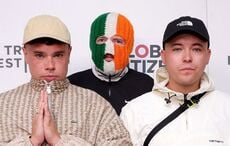Patsy Joyce was only eight years of age when his family was attacked and slaughtered in the dead of night. He later moved to America and nothing was ever heard of him again. Could you be his descendant?
An Irish TV production company, and the descendants of a family brutally murdered in a small townland in the west of Ireland in 1882 have joined forces to reach out to readers of IrishCentral in an appeal to find a ‘missing link’ to a young orphan who survived that tragic event and subsequently emigrated to the USA.
Patsy Joyce was only eight years of age when his family was attacked and slaughtered in the dead of night in Maamtrasna, a remote valley on the shores of Lough Mask, an inaccessible area on the borders of counties Galway and Mayo.

Patsy Joyce played by actor Peadar Mac Donncha at the scene where his family were murdered. Image: TG4.
Five members of the Joyce family – husband, wife, grandmother, son and daughter - were either shot or bludgeoned to death in a violent attack which left the youngest of the family, Patsy, seriously wounded.
He recovered from his injuries but his eye-witness account of the murder of his family which could have prevented a tragic miscarriage of justice was rejected by the authorities on a technicality. Innocent men, wrongly accused of the attack, were convicted on the word of informers and on perjured evidence. Those convicted were subsequently hanged or imprisoned for life while those who gave false evidence were handsomely rewarded.
All attempts to trace the whereabouts of Patsy Joyce after he emigrated to America in 1896 have to date met with failure which has prompted ROSG, a multi-award winning Galway-based film company and the Dublin based members of the Joyce family to seek the help of IrishCentral readers to re-connect any descendants of that orphaned boy with their Irish relatives.
He is known to have arrived in New York and traveled onwards to Cleveland, Ohio where his brother Martin resided at that time. Contact between the brothers was lost over the years when Martin returned to Ireland where he lived in Dublin and raised his own family.
The search for details of Patsy Joyce’s life in the USA is prompted by the transmission early next month of a feature-length drama-documentary on the Maamtrasna murders commissioned by Irish TV station TG4.
Read more: Three Irish language speakers wrongfully executed due to lack of English
Former Dublin footballer Johnny Joyce, a grandnephew of Patsy Joyce has led the search for his missing relative for the past 40 years and has visited Ellis Island as part of his research.
“Trying to trace him has been one of my main concerns over the past 40 years and I still haven’t got to the end of it yet,” he said.
Patsy Joyce’s last confirmed location was in Cleveland but “we haven’t been able to locate where and when he was there or what place he was living in at the time,” says Johnny Joyce.

Grave of the murdered Joyces. Image: TG4.
“The story of what happened to young Patsy, an eye-witness to one of Ireland’s most tragic murder stories, will forever remain untold if we don’t succeed in tracing descendants” says filmmaker Ciarán Ó Cofaigh whose production company ROSG have produced the bilingual TG4 film “Murdair Mhám Trasna” (The Maamtrasna Murders).
“Who knows what stories Patsy may have told his children or grandchildren over the years about that fateful night or what family lore may have been handed down through the generations. It would be absolutely fascinating to find that missing link,” says author Seán Ó Cuirreáin, whose book on the mysterious murder case has provided the basis for the new TV production.
Anyone who thinks they can offer any leads as to what happened to Patsy Joyce are invited to make contact with the producers at [email protected]. Further information is available on the film’s Facebook page Murdair Mhám Trasna.
Read more: Thirty-two years of heinous crimes in 19th century Ireland go online
What is known of Patsy Joyce

1882 newspaper sketch of Patsy Joyce in court giving evidence.
Patsy Joyce was born in Maamtrasna in 1874 and suffered severe injuries during the murderous attack on his family in 1882. He had no formal education and spoke only Irish, the common language of his community at that time. Left as an orphan when his family was murdered he was sent as an ‘inmate’ to Artane Industrial School in Dublin under the care of the Christian Brothers.
He was brought to court in Dublin to give evidence in the case of those accused of the murders but his evidence was never heard by the jury because he confirmed that although he understood what it was to tell a lie he did not know what the consequence of lying might be.
He was asked by the Attorney General in court, “Do you know what will happen if you tell a lie?”
“I do not,” he replied through the interpreter. He was dismissed immediately by the Attorney General who said, “There is no point in asking him any other questions.”

Patsy Joyce's evidence in court from official court transcript. Image: TG4.
Patsy Joyce remained in Artane until 1890 when he moved to Liverpool as a carpenter in Fr Nugent’s Industrial School but returned to Dublin two years later. He had an interest in hurling and was one of the founders of the Celtic Hurling Club in 1892. A newspaper report of his prowess in a championship match against Commercials Hurling Club in 1895 describes him as being “very useful with the camán.” In the same year, he was selected for the Dublin hurling team in a match against Wexford.
The following year, 1896, he set sail for the USA with a large group of other young men from the Celtic Hurling Club on board the Anchoria bound for New York. His destination was thought to be Cleveland, Ohio, but there is no further information on the fate of the young orphan who survived the Maamtrasna murders.
His story is the ‘missing link’ now sought by the TV production company and his Irish relatives.
The Maamtrasna murders – mystery, drama, and intrigue

Three convicted local men are hanged for the Maamtrasna Murders, 1882 ...in Murdair Mhám Trasna film. Image: TG4.
The Maamtrasna murder case of 1882 with its mix of murder mystery, courtroom drama, and political intrigue was the subject of extended media and parliamentary debates and eventually played a part in the fall of the British Government in 1885.
The motive for the murder of the family – John Joyce, his wife Brighid, his mother Maireád, his daughter Peigí and his son, Micheál – remains shrouded in mystery but it is generally presumed that the killings were connected with sheep stealing, a serious offence in a time of great poverty and distress in the rural west of Ireland.
Eight local men charged with the notorious Maamtrasna murders were all native Irish speakers, most of whom had little or no English. The trials in Dublin were conducted in English with a judge and jury who understood no Irish.

The Maamtrasna area.
The accused men’s solicitor, a 24-year old novice from Tuam, Co. Galway, had graduated from Trinity College Dublin only two years previously and, as a non-Irish speaker, was unable to communicate in any meaningful way with most his clients, all of whom were charged with the capital offense of murder.
Three of the men were hanged while the remaining five were given a last-minute reprieve by the Earl Spencer and had their death sentences commuted to penal servitude for life.
Three of those convicted had some involvement in the brutal massacre of the family of five but those who orchestrated and carried out the killings remained free and escaped justice.
On the gallows Myles Joyce one of the innocent men was quoted as saying, “Feicfidh mé Íosa Críost ar ball – crochadh eisean san éagóir chomh maith”. (“I will see Jesus Christ in a little while – he too was unjustly hanged/crucified.”)

Actor Dara Devanney in the part of Myles Joyce in Murdair Mhám Trasna film. Image: TG4.
Two of those convicted died in jail while the remaining three innocent prisoners were only released after they had served 20 years. Having served long sentences for crimes of which, it was widely accepted, they were innocent, the three men were sent home by train from Dublin to Ballinrobe, Co. Mayo. Arriving after nightfall, they then set out across mountainous terrain, walking the remaining 18 miles of their journey home to Maamtrasna in rain and darkness.
Attempts continue, over 136 years later, to have those innocent of the crime recognized officially as victims of a miscarriage of justice.
President Michael D. Higgins has revealed that the Government has appointed an expert to examine the case for granting posthumous pardons to the innocent men convicted of the historic murders.
In an interview featured in the new drama-documentary for TG4 “Murdair Mhám Trasna,” President Higgins said he is looking forward to hearing that expert’s opinion and the Government’s advice on one of the most famous miscarriages of justice in British and Irish legal history.
“At that stage, I will be returning to this issue to see what I can do. If it were up to me, the formalities aside, I would be happy to accept that the injustice which occurred should be recognized. My view is that the moral issue is clear,” the President said.
“Everything that happened at the level of the State was horrendous. There was bribery involved. The accused didn’t get a proper chance to defend themselves. There wasn’t an atmosphere of equality and there was no equality as regards legal processes at that time.”
The President also says that the British authorities at that time did not treat the Irish as equals: “They viewed them as a race apart who were not on equal footing with ordinary civilized people.”
Murdair Mhám Trasna available to watch on TG4
The fully-subtitled TG4 drama documentary “Murdair Mhám Trasna,” directed by Colm Bairéad, can be viewed ‘live’ free of charge on the Irish station website (www.TG4.ie) on Wednesday, April 4 at 9.30pm (GMT) or at any time subsequently on the station’s player for one month after transmission.
Anyone who thinks they can offer any leads as to what happened to Patsy Joyce are invited to make contact with the producers at [email protected]. Further information is available on the film’s Facebook page Murdair Mhám Trasna.




Comments